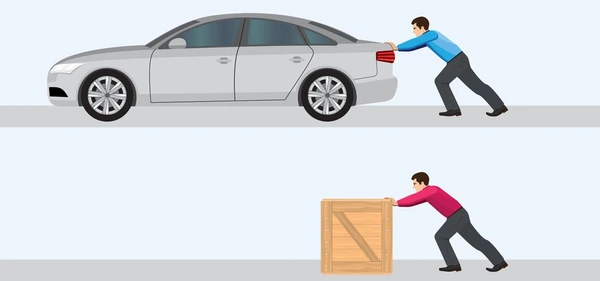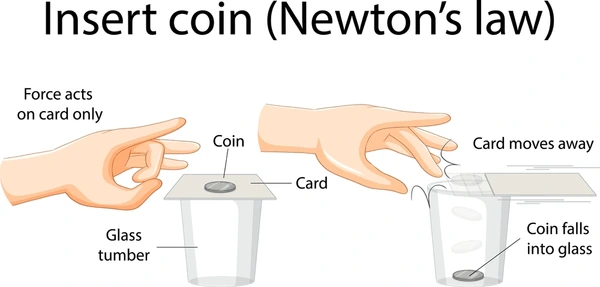Physics and Mathematics
Newton’s First Law of Motion
1. Introduction
The First Law of Motion, also known as the Law of Inertia, was first stated by Sir Isaac Newton in his book Principia Mathematica (1687).
It defines the natural tendency of objects to resist changes in their state of motion.
Statement:
“An object continues to remain in its state of rest or of uniform motion in a straight line unless compelled to change that state by an external unbalanced force.”
This law gives a qualitative definition of force — i.e., a force is required to change the state of motion of a body.
2. Understanding the Concept
Every object resists any change in its motion — this property is called inertia.
- If the object is at rest, it remains at rest until acted upon by an external force.

- If the object is in motion, it continues to move with the same velocity in a straight line unless a net external force acts on it.
Hence, Newton’s First Law defines the natural state of an object — either rest or uniform motion — as the state of zero net force.
3. Examples in Daily Life
-
- A passenger in a car leans backward when the car starts suddenly.
- A person lurches forward when the car stops abruptly.
- Dust is removed from a carpet by shaking it — dust particles resist motion and get separated.
- When a coin is placed on a card covering a glass and the card is flicked, the coin falls straight into the glass.

- When a bus starts suddenly, the lower part of your body moves with the bus, but the upper part tends to remain at rest due to inertia.
4. Types of Inertia
| Type of Inertia | Description | Example |
|---|---|---|
| Inertia of Rest | Resistance to change from rest. | A book on a table remains stationary until pushed. |
| Inertia of Motion | Resistance to change from motion. | A moving bus continues to move unless brakes are applied. |
| Inertia of Direction | Resistance to change in direction. | When a car takes a sharp turn, passengers tend to lean sideways. |
5. Mathematical Representation
From Newton’s Second Law,
[
F = ma
]
If [F = 0], then [a = 0].
Hence, velocity remains constant, which means the object continues in its current state of rest or uniform motion — this is Newton’s First Law.
6. SI Unit and Dimensional Formula
| Quantity | SI Unit | Dimensional Formula |
|---|---|---|
| Force (F) | Newton (N) | [M¹L¹T⁻²] |
| Mass (m) | kilogram (kg) | [M¹L⁰T⁰] |
| Acceleration (a) | m/s² | [M⁰L¹T⁻²] |
7. Practice Questions (With Solutions)
1. Why do passengers fall backward when a bus starts suddenly?
Solution:
When the bus starts suddenly, the lower part of the passenger’s body moves forward with the bus, but the upper part tends to remain at rest (inertia of rest). Hence, the passenger falls backward.
2. Why does dust come out of a carpet when it is beaten with a stick?
Solution:
When the carpet is beaten, it moves suddenly, but the dust particles tend to remain at rest (due to inertia). Hence, they separate and fall off.
3. A ball kept on the floor remains stationary until someone kicks it. Explain.
Solution:
The ball remains at rest because no external force acts on it. When kicked, an unbalanced force acts, setting it in motion — illustrating Newton’s First Law.
4. Why does a person move forward when a moving bus stops suddenly?
Solution:
When the bus stops suddenly, the lower part of the body stops, but the upper part continues moving forward due to inertia of motion.
5. A car moving with uniform velocity comes to rest after brakes are applied. What is the cause of stopping?
Solution:
The unbalanced retarding force (friction + braking force) acts opposite to motion, bringing it to rest — proving an external force is needed to change the state of motion.
6. Why is it dangerous to jump out of a moving bus?
Solution:
On jumping, your feet come to rest as they touch the ground, but the upper body continues moving forward due to inertia, causing imbalance and potential injury.
7. Why is it easier to push a stationary car after it starts moving?
Solution:
Initially, the car resists motion (inertia of rest). Once in motion, inertia of motion takes over, which is easier to overcome with the same force.
8. Explain why the passengers lean outward when a car takes a sharp turn.
Solution:
Due to inertia of direction, the body tends to continue in the original direction, making passengers lean outward relative to the car.
9. Why do we use seat belts in cars?
Solution:
Seat belts prevent passengers from lurching forward due to inertia when the car suddenly stops.
10. What happens when a coin placed on a card over a glass falls straight down after the card is flicked?
Solution:
The coin remains momentarily at rest (inertia of rest) when the card moves, hence it falls straight into the glass.
8. Conceptual Questions
1. Does Newton’s First Law apply in all frames of reference?
No. It is valid only in inertial frames (non-accelerating frames of reference).
2. Does a body at rest always experience zero force?
Not necessarily. It may have multiple forces that are balanced (net force = 0).
3. Is inertia a force?
No. Inertia is a property of matter, not a force.
4. Can an object move without a force acting on it?
Yes, if it’s already moving with uniform velocity (no unbalanced force).
5. What causes changes in motion?
An **external unbalanced force**.
6. What is the relation between inertia and mass?
Inertia is directly proportional to mass — heavier bodies have greater inertia.
7. Does the law of inertia contradict the second law?
No. The first law is a **special case** of the second law when \(F = 0\).
8. Why is space called a nearly perfect inertial frame?
Because there are minimal external forces acting on bodies in deep space.
9. If no force acts, can an object move in a circle?
No. Circular motion requires a centripetal force, hence not purely inertial.
10. Can a body have motion without force?
Yes, if no external unbalanced force acts — it can continue uniform motion.
9. FAQs / Common Misconceptions
1. Inertia and force are the same.
❌ Incorrect. Inertia is the tendency to resist change; force is what causes the change.
2. If there is no force, an object must be at rest.
❌ Wrong. It may also move with uniform velocity in a straight line.
3. A moving object always needs a force to keep it moving.
❌ False. A force is only required to overcome friction or change motion, not maintain it.
4. Heavier bodies have less inertia.
❌ Opposite. Heavier bodies have more inertia.
5. If acceleration is zero, force must be absent.
⚠️ Not always. It means **net force** is zero; forces can be balanced.